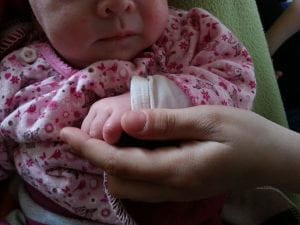Mucolipidosis Type III (ML III or Pseudo-Hurler Polydystrophy)
What is mucolipidosis type III (pseudo-Hurler polydystrophy)?
Pseudo-Hurler polydystrophy is a milder and the third form of mucolipidosis, producing less severe symptoms and progressing slower than others. Mucolipidosis affects the body’s ability to perform normal processes that involve the turnover of materials within cells. Pseudo-Hurler polydystrophy is a disorder that can affect many parts of the body.
Symptoms usually do not appear until a child is 2-5 years old, and then worsen over time. While the exact prevalence is unknown, it is estimated that pseudo-Hurler polydystrophy occurs in about 1 in 100,000 to 400,000 people. It affects males and females equally.
What are the symptoms of mucolipidosis type III (pseudo-Hurler polydystrophy)?
It is important to note that each individual may not have every symptom listed here. They include:
- Stiffness in the hands and shoulders
- Slow growth
- Short height
- Stiff joints
- Skeletal deformities
- Claw-like deformities in the hands
- Carpal tunnel syndrome
- Scoliosis
- Degeneration of the hip
- Weakened bones that fracture easily (osteoporosis)
- Worsening joint and bone pain
- Development of coarse facial features
- Mild clouding of the cornea of the eye
- Frequent ear and respiratory infections
- Heart valve abnormalities
Patients with pseudo-Hurler polydystrophy are usually of normal intelligence, though some may have mild learning disabilities.
What causes mucolipidosis type III (pseudo-Hurler polydystrophy)?
Pseudo-Hurler polydystrophy is brought about by a mutation that causes a deficiency in an enzyme called UDP-N-acetylglucosamine-1-phosphotransferase. This enzyme tags other enzymes, telling them where to go. When it doesn’t tag the other enzymes, they escape the cell and thus don’t go where they’re supposed to. This results in the accumulation of other substances within the cells, which leads to the symptoms of the disorder. Researchers suspect that pseudo-Hurler polydystrophy is generally a milder form of mucolipidosis because the deficient enzyme isn’t completely inactive. This would result in a smaller accumulation of materials inside cells.
To learn more about how the mucolipidoses are caused and inherited, click here.
How is mucolipidosis type III (pseudo-Hurler polydystrophy) diagnosed?
Pseudo-Hurler polydystrophy is diagnosed using the following procedures:
- Thorough clinical evaluation
- Recording of patient history
- Specialized lab testing
What are the treatments for mucolipidosis type III (pseudo-Hurler polydystrophy)?
Pseudo-Hurler polydystrophy treatment is supportive and catered to the symptoms of each individual patient. It includes:
- Surgery for treating: skeletal malformations, carpal tunnel syndrome, hip degeneration, heart valve replacement, etc.
- Corneal transplantation
- Physical therapy
- Exercise to lessen joint stiffness
- Genetic counseling
- Other symptomatic treatments
Where can I find out more about mucolipidosis type III (pseudo-Hurler polydystrophy)?
Mucolipidosis Type III (ML III or Pseudo-Hurler Polydystrophy) Articles

Rare Disease Families Have Extensive Experience in “Letting Go”


Complementary Medicine is Embraced by Rare Disease Families


Siblings: The Unsung Heroes of Rare Disease Families






